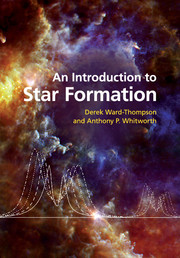Book contents
- Frontmatter
- Contents
- List of Illustrations
- Preface
- 1 Introduction
- 2 Probing star formation
- 3 The ISM – the beginnings of star formation
- 4 Molecular clouds – the sites of star formation
- 5 Fragmentation and collapse – the road to star formation
- 6 Young stars, protostars and accretion – building a typical star
- 7 The formation of high-mass stars, and their surroundings
- 8 By-products and consequences of star formation
- List of mathematical symbols
- List of figure credits
- Index
- References
6 - Young stars, protostars and accretion – building a typical star
Published online by Cambridge University Press: 05 June 2012
- Frontmatter
- Contents
- List of Illustrations
- Preface
- 1 Introduction
- 2 Probing star formation
- 3 The ISM – the beginnings of star formation
- 4 Molecular clouds – the sites of star formation
- 5 Fragmentation and collapse – the road to star formation
- 6 Young stars, protostars and accretion – building a typical star
- 7 The formation of high-mass stars, and their surroundings
- 8 By-products and consequences of star formation
- List of mathematical symbols
- List of figure credits
- Index
- References
Summary
Pre-main-sequence evolution
In this chapter we follow the evolution from a collapsing core in a molecular cloud to a newly formed star as it approaches the main sequence on the Hertzsprung–Russell (HR) diagram. Figure 6.1 sketches the paths followed during the various evolutionary stages on an HR diagram. In this section we briefly outline the various evolutionary stages, and in successive sections we deal with each stage in more detail.
Isothermal collapse
Once a pre-stellar core becomes gravitationally unstable and starts to collapse, then initially the released gravitational energy is freely radiated away and the collapsing fragment stays at roughly the same temperature (isothermal). Its temperature would place it on the right-hand side of the HR diagram (cool), and it has a relatively large radius and hence luminosity. Consequently, it should begin its evolution at the upper right of the HR diagram. Its luminosity is supplied by contraction and the consequent release of gravitational potential energy.
The isothermal collapse phase produces a central concentration of matter and ends with the formation of an opaque, hydrostatic object at the centre, surrounded by a gaseous envelope. We define a hydrostatic object as one which supports itself against gravity by its own internal pressure.
- Type
- Chapter
- Information
- An Introduction to Star Formation , pp. 117 - 142Publisher: Cambridge University PressPrint publication year: 2011



